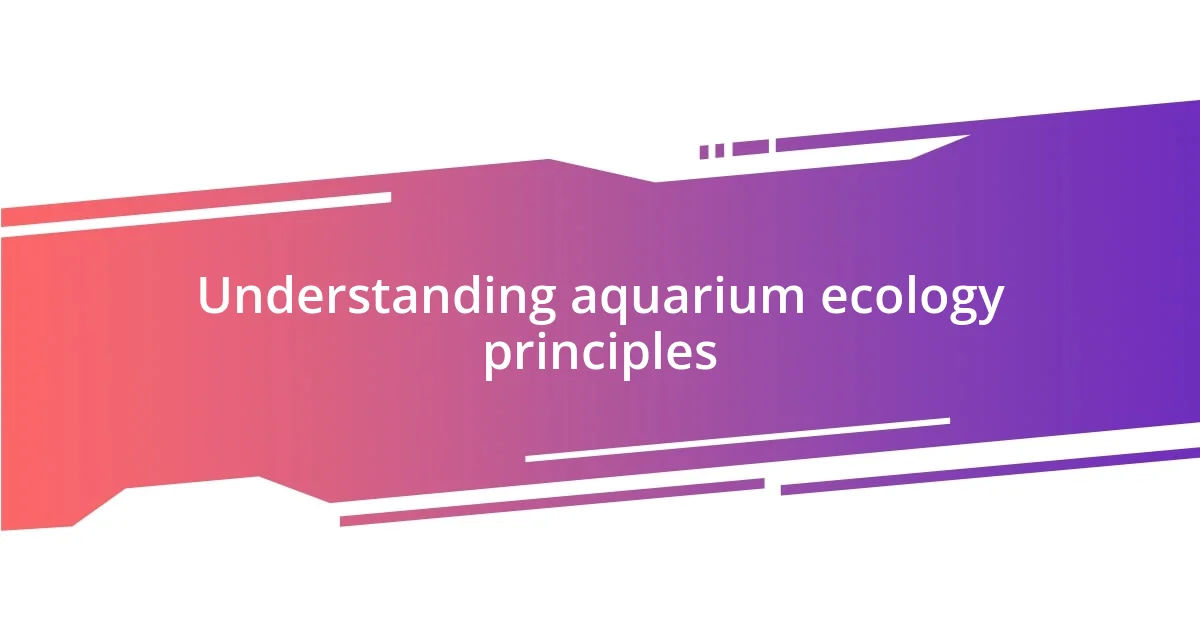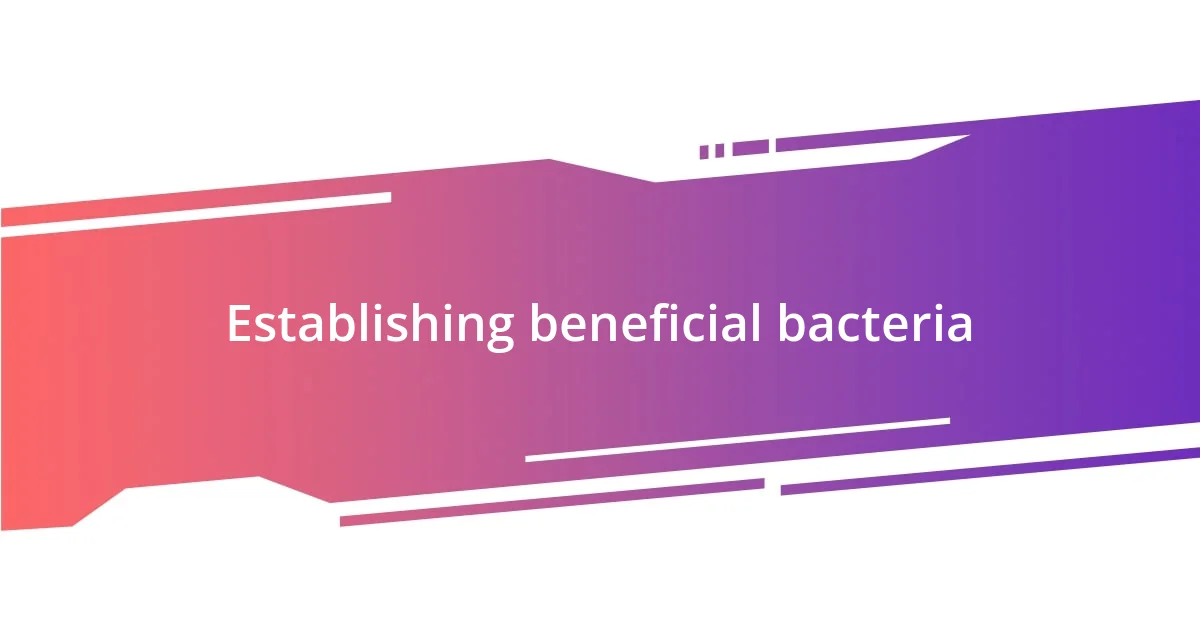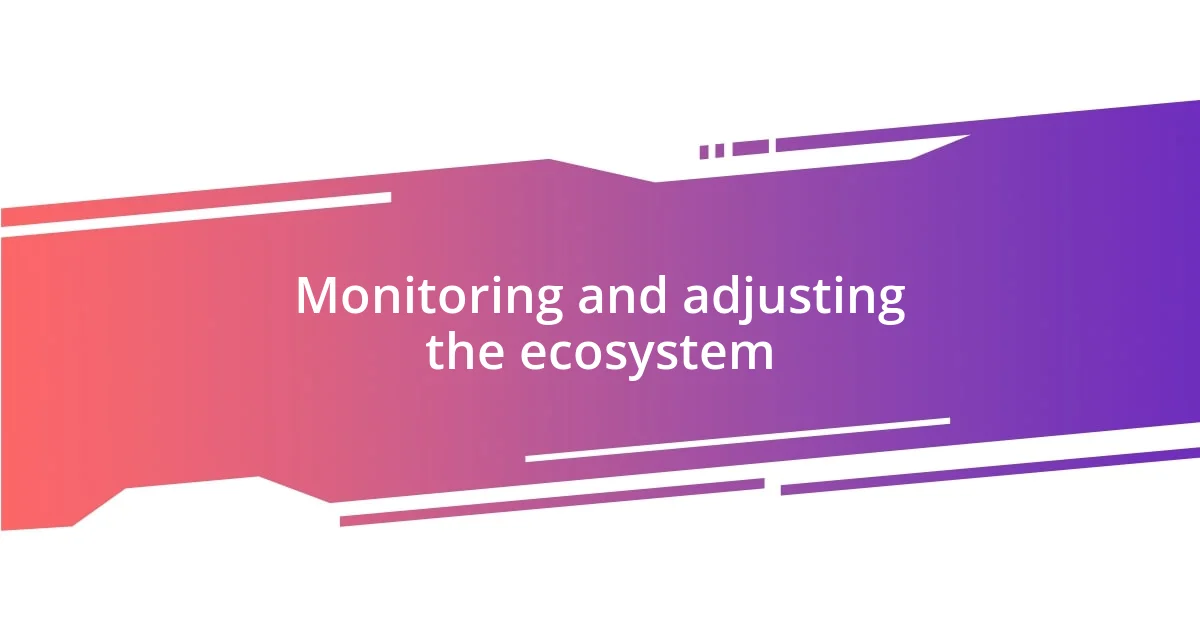Key takeaways:
- Understanding aquarium ecology is crucial for maintaining a balanced ecosystem; beneficial bacteria play a vital role in waste management.
- Selecting the right tank setup involves considering size, shape, and filtration to create a suitable environment for fish and plants.
- Regular monitoring and maintenance of water quality parameters, along with attentiveness to fish behavior, are essential for a thriving aquarium.

Understanding aquarium ecology principles
Understanding the principles of aquarium ecology is essential for creating a thriving environment for your fish and plants. I’ve found that every decision I make—whether it’s selecting tank mates or managing water parameters—directly impacts the delicate balance of my setup. It’s truly fascinating how these tiny ecosystems mirror nature, showcasing connections and interactions that can be both intricate and beautiful.
One fundamental aspect of aquarium ecology is the relationship between beneficial bacteria and waste management. I remember the first time my tank suffered from an ammonia spike; the panic was overwhelming. It taught me that nurturing those helpful bacteria is vital because they break down harmful substances and keep the water healthy. Without them, my aquatic friends would struggle to thrive, highlighting the importance of these unseen allies.
Have you ever considered the role of plants in your tank? In my experience, live plants do wonders for maintaining balance. They not only provide oxygen but also absorb excess nutrients, helping to prevent algae blooms. It’s like having a little team working together, and each plant’s unique character contributes to the overall harmony of the aquarium.

Choosing the right tank setup
Choosing the right tank setup involves more than just picking a container; it’s about crafting a mini-ecosystem that can sustain life. I still remember the excitement of setting up my first aquarium. I opted for a 20-gallon tank thinking bigger would be better. However, I learned the hard way that every setup has its limitations and specific needs, from water parameters to space constraints, which can affect the types of fish and plants you can keep.
When selecting a tank, consider the shape and size in relation to the species you wish to house. For example, taller tanks work wonderfully for bettas who enjoy exploring vertical spaces. On the other hand, I discovered that a long tank provides ample room for freshwater schooling fish like tetras. Their natural behavior to swim in groups creates a vibrant display, making the choice of tank crucial to their well-being and happiness.
Lastly, think about filtration and lighting in your setup. Investing in a quality filter has made a world of difference in maintaining clear water. I once tried a cheaper option, only to find my tank becoming cloudy and algae-infested. It’s these little experiences that shaped my understanding—your tank’s setup is the foundation of its ecosystem; getting it right is essential for a balanced aquarium.
| Tank Size | Best Uses |
|---|---|
| 5-10 Gallons | Betta, Shrimp |
| 20 Gallons | Small Schooling Fish |
| 40 Gallons+ | Community Tanks |

Selecting compatible fish species
When it comes to selecting compatible fish species, my experience has taught me that understanding behavior and temperament is crucial. For instance, I learned the hard way that not all fish play nicely together. I once paired aggressive cichlids with peaceful tetras, and it ended in a miniature disaster. Now, I take the time to research each species’ needs and social dynamics before making any decisions.
Here are some tips for selecting compatible fish species:
- Research Temperament: Look into whether the species are aggressive or docile.
- Size Matters: Ensure that larger fish don’t see smaller ones as snacks.
- Schooling Needs: Some fish thrive in groups; consider their social behavior.
- Water Parameter Compatibility: Check if their requirements align, such as pH and temperature.
- Avoid Similar Species: Different species can exhibit territorial behavior, leading to conflicts.
By focusing on these factors, I’ve created a harmonious aquarium where every fish has its own space and thrives together. It’s immensely rewarding to watch my tank come to life, all because of thoughtful planning and understanding of my aquatic companions.

Maintaining water quality parameters
Maintaining water quality parameters is one of those tasks that can make or break your aquarium experience. I learned early on that neglecting this aspect leads to unforeseen troubles. For instance, I had a particularly vibrant tank that suddenly turned murky overnight, and I panicked. It turned out my ammonia levels skyrocketed. Regular testing with reliable kits has since become non-negotiable for me.
Every week, I test not just ammonia, but also nitrite and nitrate levels. If you’ve ever faced the stress of a fish loss, you’ll appreciate the peace of mind that comes with being proactive. It’s kind of like having a health check-up—keeping a close eye not only avoids surprises but helps create a thriving environment. After a few rounds of tests, I’ve established a routine that feels almost second nature now.
Temperature is another vital parameter that shouldn’t be overlooked. I remember when I thought a heater was optional, and I witnessed my fish becoming sluggish and hiding more than usual. Once I committed to maintaining a stable temperature, the entire atmosphere in my aquarium changed. My fish became active and colorful again! It’s fascinating how such small details can significantly impact the life within your tank. How do you ensure your water’s just right? Trust me; once you establish a routine, it becomes almost second nature.

Establishing beneficial bacteria
When it comes to establishing beneficial bacteria in an aquarium, I find the nitrogen cycle is truly the backbone of a healthy ecosystem. Initially, I was intimidated by the idea of cycling my tank, but after a few early missteps, like introducing fish before the cycle completed, I learned the importance of patience. The first time I waited several weeks for the ammonia and nitrite levels to stabilize, I felt like a proud parent watching my little world come to life.
I use a combination of established filter media and starter bacteria to jumpstart this process. Once, I added a filter sponge from a friend’s tank, and I couldn’t believe the difference it made! Within days, my bacteria colony thrived, breaking down waste efficiently. It’s amazing how these tiny microbes play a crucial role in keeping the environment stable and healthy. Do you ever feel like you’re nurturing a mini ecosystem? Because that’s how I see it every time I peek into my tank.
Additionally, I’ve learned that keeping excess nutrients in check can directly affect bacterial health. During a period when I overfed my fish, I noticed a spike in unwanted algae. It reminded me that every action in the tank has a reaction—just like life. Now, I always monitor my feeding practices closely; I total the amount and adjust accordingly. Balancing food intake not only benefits my fish but keeps the beneficial bacteria thriving as well. Does it ever feel like a delicate dance to you? That’s part of the joy of aquarium keeping!

Regular tank maintenance routines
Regular tank maintenance routines have been a game-changer in my aquarium journey. I found that committing to a weekly cleaning schedule not only improves my tank’s appearance but also contributes significantly to the overall health of my aquatic life. You know that satisfying feeling when everything looks spotless? That’s my reward for putting in the effort. Simple things like changing a portion of the water and scrubbing algae off the glass quickly became rituals I genuinely look forward to.
I remember one particularly busy week when I skipped my regular maintenance, thinking it wouldn’t matter. That’s when I first witnessed the repercussions—a slight odor and my fish seemed more stressed than usual. It was a wake-up call for me. Now, I make it a point to perform 15-20% water changes, vacuuming the substrate and cleaning the filter sponge. These small, repeated actions help keep harmful toxins at bay. Have you experienced a similar moment of clarity? Trust me, regularity makes a significant difference.
Adhering to a feeding schedule is another critical part of my maintenance routine. I used to believe that my fish would thrive on constant food, but over time, I realized how much this affected my water quality. Now, I feed them just once a day, and it feels great to see them eagerly waiting for that meal. Watching them eat in a calm, stable environment makes all my efforts worthwhile. After all, isn’t it amazing how just a little structure can change the whole atmosphere of your underwater universe? I truly enjoy these simple yet impactful aspects of aquarium care!

Monitoring and adjusting the ecosystem
Monitoring the ecosystem in my aquarium has become an essential part of my routine. I use water testing kits to check parameters like pH, ammonia, nitrite, and nitrate levels weekly. I remember the first time I spotted a rise in ammonia—my heart sank. This taught me the importance of staying vigilant; those little routines can turn a potential crisis into a manageable situation. Have you ever caught a problem just in the nick of time?
Adjusting is equally vital as monitoring, and I often find myself making small tweaks based on my observations. For example, I once had to lower the light intensity after noticing an algae bloom. It was fascinating to see how quickly the entire environment responded. I adjusted the schedule and, before I knew it, my tank was thriving again. Isn’t it incredible how an ecosystem can evolve with a few adjustments? I genuinely enjoy witnessing that growth.
Also, I’ve discovered that maintaining a balance goes beyond just the water chemistry. I pay attention to my fish’s behavior, too. When one of my angelfish started hiding more than usual, I intuitively checked the water parameters and found a slight imbalance. Adjusting the temperature and adding some plants brought back their spunky personalities. It’s moments like these that remind me how interconnected every element in my aquarium is. Does it ever surprise you how aware you need to be of both the water and your fish’s moods?















